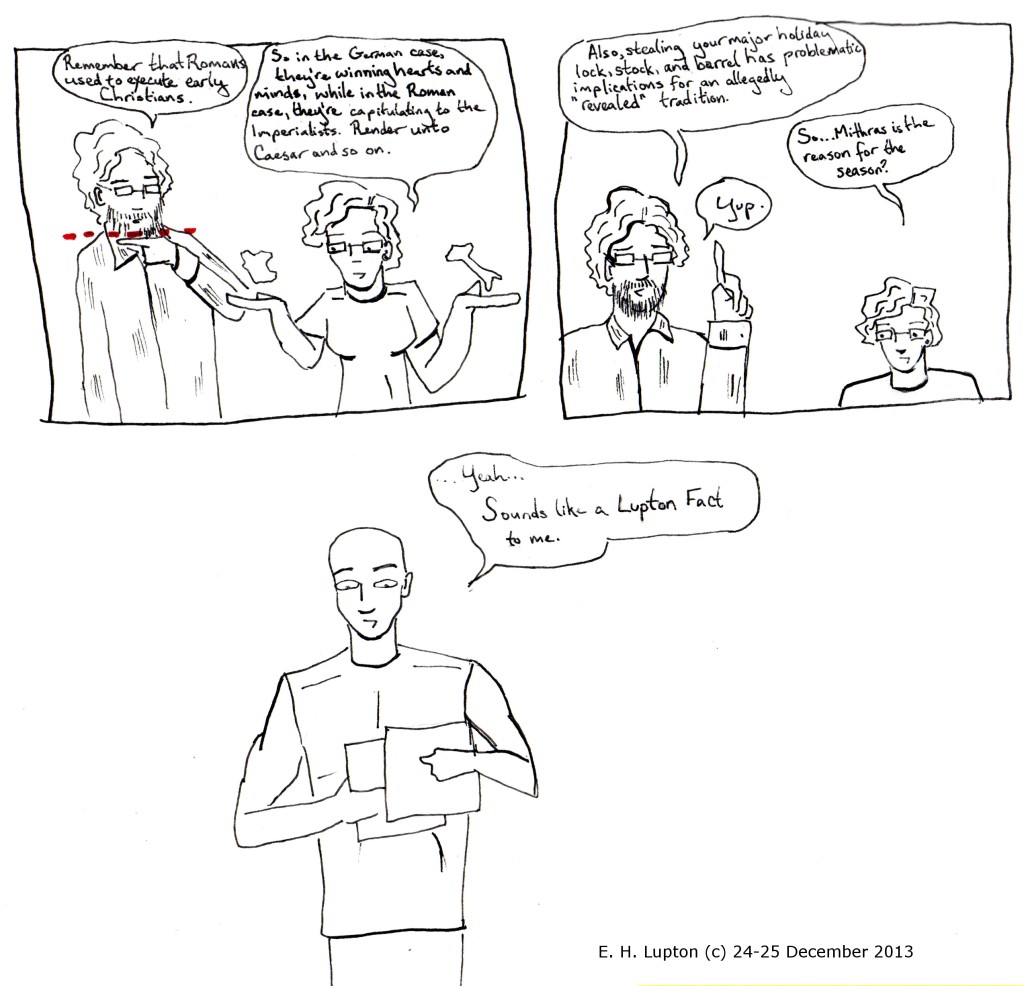I should clarify straight away that “Lupton Fact” is the term B uses for claims that I (and my brothers) claim that occasionally turn out to not be true, or not be entirely true.
Usually when I do comics about history or philosophy I fact check them pretty closely. This one, I did not–mostly it was a good story that I wanted to transcribe. To be honest, the word “mystery” in the term “Mithraic Mysteries” (or “Mysteries of Mithras”) means that you didn’t get to find out much about the rituals and so on until you had been initiated into the religion–it’s the modern-day equivalent of Free Masonry. Or Scientology. No writings from the Mithras cult survive, as far as I know, and all of what we know about them is based on supposition drawn from artworks, artifacts found in caves (where they held their rites), and a few contemporaneous writings, including one early church father. In short, we don’t really know what they believed or who they stole from. They were contemporaneous in time with Christianity, certainly, but whether they were contemporaneous in geography is a question. It seems that at least some of the similarities between Christianity and the Mysteries of Mithras may have been drummed up by the New Atheist Movement to score points on Christianity.
That said, it’s a good story.
I wanted to make this chat longer, but I’m really tired, so I’m just going to file this under BR128.M5 L86 2013, for Christianity–Relation of Christianity to other religious and philosophical systems–Special, A-Z–Mithraism. And now to bed.
OH, by the way. If you read my book, and you happen to be on Goodreads, it’s on there–you can leave a review! Exciting, eh?
Update!
Sean messaged me this morning to provide an alternate account of the connection between Mithraism and Christianity. It goes something like this:
- The religions of Rome were very ritual-centric, rather than focusing on belief in a specific deity, so much so that late empire writers complained that no one understood the meaning behind or origin of the rituals yet had to fulfill them.
- When Rome adopted Christianity as its religion, these people might have brought some of their rituals with them to Christianity.
- A lot of religions make a connection between their deity and the sun [For perhaps obvious reasons, since you’d want to connect a life-bringing deity with the life-bringing sun.–Ed.]. In Islam, for example, the angel Gabriel appears to Mohammed (BPuH) as a giant in the sky. In the Hebrew Bible, G-d is frequently described with solar/light-related metaphors.
- A lot of Roman cults had resurrection myths. But Jews (and especially the Nazarites) did sin offerings. [Ok, there are appearances of offerings all over the Hebrew Bible–for example, the “scapegoat” thing in Lev. 16:8 or Hannah dedicating her son in 1 Sam. 1:24. So I don’t know if this was just especially a Nazarite thing or what–Sean didn’t specify. Jews in general made offerings.–Ed.] It’s not a big step from an offering one person makes to clear one person of sin to an offering made to cleanse all of humanity of sin. So Christianity could certainly have picked up a lot of its beliefs from extant Jewish mythology.
- In summary, certainly a bunch of the harmless stuff, like bunnies that lay eggs, Christmas trees, lights, etc. probably came from Roman cults. But the rest, it’s hard to say, and harder still because some of the people who are interested in propagating this train of thought are doing so to discredit Christianity as a religion. [Whatever that means. I don’t see the fact that a religion has particular sociocultural/historical roots as incompatible with believing in it, but even in my religious days I was never a literalist.–Ed.]


